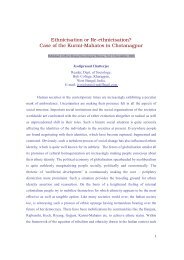Chapter 5 - WebRing
Chapter 5 - WebRing
Chapter 5 - WebRing
You also want an ePaper? Increase the reach of your titles
YUMPU automatically turns print PDFs into web optimized ePapers that Google loves.
CHAPTER 5. MAGNETIC SYSTEMS 255<br />
and set H = 0. For simplicity, the initial orientation of the spins is all spins up.<br />
(a) Choose T = 10 and run until equilibrium has been established. Is the orientation of the spins<br />
random such that the mean magnetization is approximately equal to zero? What is a typical<br />
size of a domain, a region of parallel spins?<br />
(b) Choose a low temperature such as T = 0.5. Are the spins still random or do a majority<br />
choose a preferred direction? You will notice that M ≈ 0 for sufficient high T and M = 0<br />
for sufficiently low T. Hence, there is an intermediate value of T at which M first becomes<br />
nonzero.<br />
(c) Start at T = 4 and determine the temperature dependence of the magnetization per spin m,<br />
the zero-field susceptibility χ, the mean energy E, and the specific heat C. (Note that we have<br />
used the same notation for the specific heat and the heat capacity.) Decrease the temperature<br />
in intervals of 0.2 until T ≈ 1.6, equilibrating for at least 1000mcs before collecting data at<br />
each value of T. Describe the qualitative temperature dependence of these quantities. Note<br />
that when the simulation is stopped, the mean magnetization and the mean of the absolute<br />
value of the magnetization is returned. At low temperatures the magnetization can sometimes<br />
flip for small systems so that the value of 〈|M|〉 is a more accurate representation of the<br />
magnetization. For the same reason the susceptibility is given by<br />
χ = 1 2 2<br />
〈M 〉−〈|M|〉<br />
kT<br />
, (5.103)<br />
rather than by (5.17). A method for estimating the critical exponents is discussed in Problem<br />
5.41.<br />
(d) Set T = Tc ≈ 2.269 and choose L ≥ 128. Obtain 〈M〉 for H = 0.01, 0.02, 0.04, 0.08, and 0.16.<br />
Make sure you equilibrate the system at each value of H before collecting data. Make a log-log<br />
plot of m versus H and estimate the critical exponent δ using (5.99).<br />
(e) Choose L = 4 and T = 2.0. Does the sign of the magnetization change during the simulation?<br />
Choose a larger value of L and observe if the sign of the magnetization changes. Will the sign<br />
of M change for L ≫ 1? Should a theoretical calculation of 〈M〉 yield 〈M〉 = 0 or 〈M〉 = 0<br />
for T < Tc?<br />
∗ Problem 5.14. Ising antiferromagnet<br />
Sofarwehaveconsideredthe ferromagneticIsingmodelforwhichtheenergyofinteractionbetween<br />
two nearest neighbor spins is J > 0. Hence, all spins are parallel in the ground state of the<br />
ferromagnetic Ising model. In contrast, if J < 0, nearest neighbor spins must be antiparallel to<br />
minimize their energy of interaction.<br />
(a) Sketch the ground state of the one-dimensional antiferromagnetic Ising model. Then do the<br />
same for the antiferromagnetic Ising model on a square lattice. What is the value of M for<br />
the ground state of an Ising antiferromagnet?

















